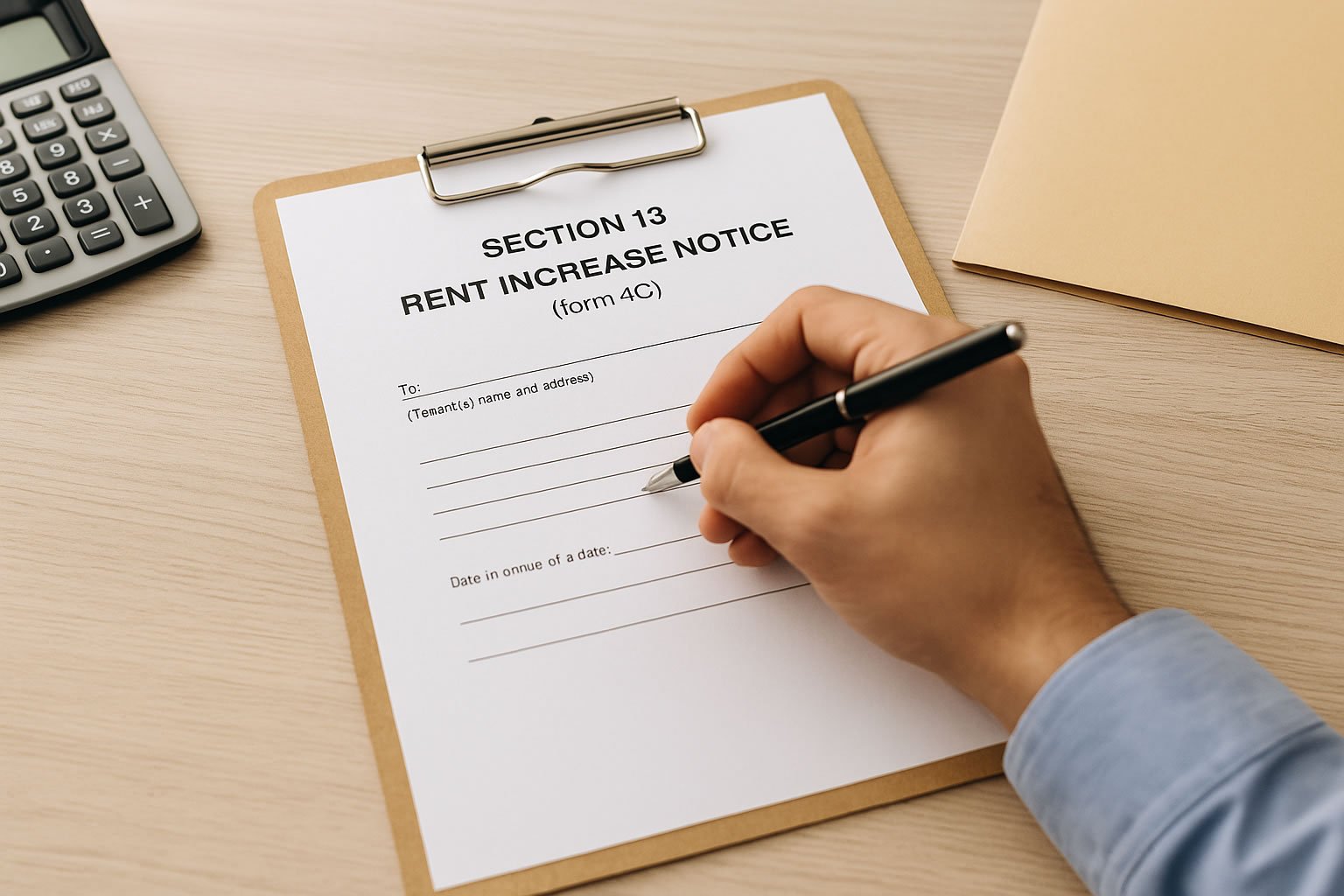
Section 13 Rent Increase Notice: A Complete Guide for UK Landlords
What Is a Section 13 Notice?
A Section 13 notice is a legal document used by landlords in England and Wales to propose a rent increase for assured shorthold tenancies (ASTs). Named after Section 13 of the Housing Act 1988, this notice provides a structured way for landlords to request rent increases while ensuring tenant rights are protected.
The Section 13 notice serves as formal communication between landlord and tenant, establishing clear terms for the proposed rent increase. Unlike informal rent increase requests, a Section 13 notice carries legal weight and must follow specific procedures to be valid.
Key Features of Section 13 Notices
- Legal Framework: Based on Housing Act 1988 Section 13
- Tenancy Types: Applies to assured shorthold tenancies
- Geographic Scope: England and Wales (Scotland has different procedures)
- Purpose: Formal rent increase proposals during tenancy periods
When Can You Use a Section 13 Notice?
Understanding when you can legally serve a Section 13 notice is crucial for landlords. The timing and circumstances must align with specific legal requirements to ensure the notice is valid and enforceable.
Tenancy Requirements
| Requirement | Details |
|---|---|
| Tenancy Type | Must be an assured shorthold tenancy (AST) |
| Fixed Term Status | Can be used during or after fixed term expires |
| Previous Increases | Must wait 52 weeks since last rent increase |
| Tenancy Duration | No minimum tenancy length required |
Timing Considerations
The timing of your Section 13 notice is critical. You cannot serve a notice if:
- Less than 52 weeks have passed since the last rent increase
- The tenancy agreement specifically prohibits rent increases
- You’re currently in dispute proceedings with the tenant
- The property doesn’t meet legal standards for rental properties
Circumstances Where Section 13 Applies
During Fixed Terms: If your tenancy agreement doesn’t include rent review clauses, a Section 13 notice allows you to propose increases even during fixed terms.
Periodic Tenancies: When fixed terms expire and become periodic, Section 13 notices provide the standard method for rent increases.
Market Rate Adjustments: When local rental markets have increased significantly, Section 13 notices help align your rental income with current market rates.
Step-by-Step: Filling Out the Section 13 Form
Completing a Section 13 form correctly is essential for legal validity. Each section requires specific information, and errors can invalidate the entire notice.
Essential Information Required
Property Details
- Complete property address including postcode
- Description of the property (house, flat, number of bedrooms)
- Any specific areas included or excluded from the tenancy
Tenancy Information
- Current tenancy start date
- Type of tenancy agreement
- Names of all tenants as they appear on the original agreement
Rent Details
- Current rent amount and payment frequency
- Proposed new rent amount
- Date from which the increase will take effect
Form Sections Breakdown
Section A – Property Address: Enter the complete address exactly as it appears on the tenancy agreement. Include any flat numbers, building names, and ensure the postcode is correct.
Section B – Tenant Information: List all tenant names exactly as they appear on the original tenancy agreement. Middle names and spelling must match precisely.
Section C – Current Rent: Specify the current rent amount and how frequently it’s paid (weekly, monthly, etc.). Include any services included in the rent.
Section D – Proposed Rent: State the new rent amount and confirm the payment frequency remains the same unless specifically changing.
Section E – Effective Date: The earliest date you can specify is determined by notice period requirements (typically one rental period plus one day).
Common Mistakes to Avoid
- Incorrect tenant names: Always use names exactly as they appear on the tenancy agreement
- Wrong effective dates: Ensure you’re giving adequate notice periods
- Incomplete property descriptions: Be specific about what’s included in the tenancy
- Mathematical errors: Double-check all rent calculations and dates
For landlords seeking a professionally prepared Section 13 form, consider using our Section 13 Rent Increase Notice Form, which ensures all legal requirements are met and reduces the risk of errors.
Serving the Notice Correctly
Proper service of your Section 13 notice is as important as completing the form correctly. Improper service can invalidate the notice, forcing you to start the process again.
Acceptable Service Methods
Hand Delivery: The most reliable method is personally handing the notice to the tenant. This provides immediate proof of service and eliminates postal delays.
Recorded Delivery: Using Royal Mail’s recorded delivery service provides proof of posting and delivery, creating a paper trail for legal purposes.
Email Service: If your tenancy agreement specifically allows electronic service and the tenant has consented, email may be acceptable.
Service Timeline Requirements
The notice period depends on your tenancy payment frequency:
| Payment Frequency | Minimum Notice Period |
|---|---|
| Weekly | 4 weeks |
| Monthly | 1 month |
| Quarterly | 3 months |
| Yearly | 6 months |
Documentation and Evidence
Always maintain comprehensive records of service:
- Date and time of service
- Method used for service
- Witness information if hand-delivered
- Postal receipts if using recorded delivery
- Photographs of the notice if relevant
How Can You Raise Rent?
UK landlords have several methods available for increasing rent, each with specific legal requirements and appropriate circumstances.
Contract-Based Increases
If your tenancy agreement includes rent review clauses, you can use these provisions to increase rent. These clauses typically specify:
- How much rent can be increased
- When increases can occur
- What notice must be given
- Whether increases are automatic or require negotiation
Section 13 Notice Method
When tenancy agreements don’t include rent review clauses, or when you want to increase rent beyond contractual limits, Section 13 notices provide the legal framework.
Advantages of Section 13 Notices
- Works with any AST regardless of contract terms
- Provides legal protection for both parties
- Allows market rate adjustments
- Creates formal documentation trail
Negotiation and Agreement
Landlords can always negotiate rent increases directly with tenants. If tenants agree to increases voluntarily, formal notices aren’t required. However, written confirmation of any agreement protects both parties.
Market Rate Considerations
When determining appropriate rent increases, consider:
- Local market rates: Research comparable properties in your area
- Property improvements: Factor in any upgrades or improvements made
- Economic conditions: Consider inflation and local economic factors
- Tenant relationships: Balance financial needs with tenant retention
How Much Notice Must You Give to Raise Rent?
Notice periods for rent increases are strictly regulated and vary based on tenancy terms and payment frequency.
Standard Notice Periods
For Section 13 Notices:
- Minimum one rental period plus one day
- Cannot be less than one month
- Must expire on the same day of the month as rent is due
Calculating Notice Periods
Monthly Tenancies: If rent is paid monthly on the 1st, and you serve notice on January 15th, the earliest effective date would be March 1st (more than one month plus one day).
Weekly Tenancies: For weekly rent paid on Fridays, serving notice on Monday would require the increase to take effect on a Friday at least four weeks and one day later.
Special Circumstances
Fixed Term Tenancies: During fixed terms, you must wait until the term expires unless the agreement includes specific rent review clauses.
Periodic Tenancies: These follow standard notice period rules based on payment frequency.
Joint Tenancies: Notice must be served on all tenants, and the notice period applies to all parties collectively.
Notice Period Calculation Table
| Tenancy Type | Payment Frequency | Minimum Notice | Effective Date Rules |
|---|---|---|---|
| Periodic | Weekly | 4 weeks + 1 day | Must align with rent due date |
| Periodic | Monthly | 1 month + 1 day | Must align with rent due date |
| Periodic | Quarterly | 3 months | Must align with rent due date |
| Fixed Term | Any | Until term expires | Subject to contract terms |
Legal Protections and Tenant Rights
Understanding tenant rights and legal protections helps landlords navigate the rent increase process more effectively while maintaining positive landlord-tenant relationships.
Tenant Response Options
When tenants receive a Section 13 notice, they have several options:
Accept the Increase: Tenants can accept the proposed rent increase, which then becomes effective on the specified date.
Negotiate: Tenants may propose alternative amounts or request delayed implementation dates.
Refer to Tribunal: Tenants can challenge the increase through the First-tier Tribunal (Property Chamber) if they believe it’s unreasonable.
End the Tenancy: Tenants may choose to terminate the tenancy rather than accept the increase.
Tribunal Considerations
The First-tier Tribunal considers several factors when reviewing rent increase challenges:
- Market rates: Comparison with similar properties in the area
- Property condition: Current state and any improvements made
- Tenant improvements: Modifications made by tenants at their expense
- Economic factors: General market conditions and inflation
Landlord Responsibilities
Throughout the rent increase process, landlords must:
- Maintain property standards: Ensure properties meet legal requirements
- Provide proper notice: Follow all legal notice requirements precisely
- Respect tenant rights: Allow tenants time to consider and respond
- Document everything: Keep comprehensive records of all communications
Best Practices for Successful Rent Increases
Implementing rent increases successfully requires more than legal compliance. Following best practices helps maintain positive tenant relationships while achieving fair rental income.
Communication Strategies
Advance Warning: While not legally required, informal discussions about potential increases help prepare tenants and reduce conflicts.
Justification: Clearly explain reasons for increases, such as market changes, property improvements, or increased costs.
Flexibility: Consider tenant circumstances and be willing to negotiate timing or amounts when appropriate.
Timing Considerations
Market Timing: Consider local market conditions and seasonal factors that might affect tenant ability to pay or find alternative accommodation.
Tenant Circumstances: Be aware of significant life changes or financial difficulties that might affect tenant responses.
Property Cycle: Align increases with maintenance schedules or improvement programs when possible.
Documentation and Record Keeping
Maintain comprehensive records including:
- All communications with tenants regarding rent increases
- Market research supporting your proposed increases
- Property improvement receipts justifying cost-based increases
- Service records proving proper notice was given
Get Your Professional Section 13 Document
Preparing legally compliant Section 13 notices requires attention to detail and understanding of current legal requirements. Our Section 13 Rent Increase Notice Form provides professionally drafted documents that ensure compliance with all legal requirements.
Benefits of Professional Documentation
- Legal compliance: Ensures all statutory requirements are met
- Error reduction: Minimizes common mistakes that invalidate notices
- Professional presentation: Creates positive impressions with tenants
- Time saving: Eliminates research and drafting time
What’s Included
- Complete Section 13 form with guidance notes
- Service instructions and timeline calculators
- Template letters for tenant communications
- Legal reference materials and updates
Conclusion
Section 13 Rent Increase Notices provide UK landlords with a robust legal framework for adjusting rental income to reflect market conditions and property improvements. Success depends on understanding legal requirements, following proper procedures, and maintaining positive tenant relationships throughout the process.
Key takeaways for landlords include
- Understand timing requirements: Proper notice periods are essential for legal validity
- Complete forms accurately: Every detail matters for legal compliance
- Serve notices properly: Use appropriate methods and maintain documentation
- Consider tenant perspectives: Balance financial goals with relationship management
- Stay informed: Keep up with legal changes and market conditions
By following this comprehensive guide and utilizing professional resources like our Section 13 form service, landlords can navigate rent increases confidently while protecting their interests and maintaining compliance with UK housing law.
Remember that rental property management involves ongoing legal responsibilities. When in doubt, consult with qualified legal professionals or property management experts to ensure your practices align with current regulations and best practices.




